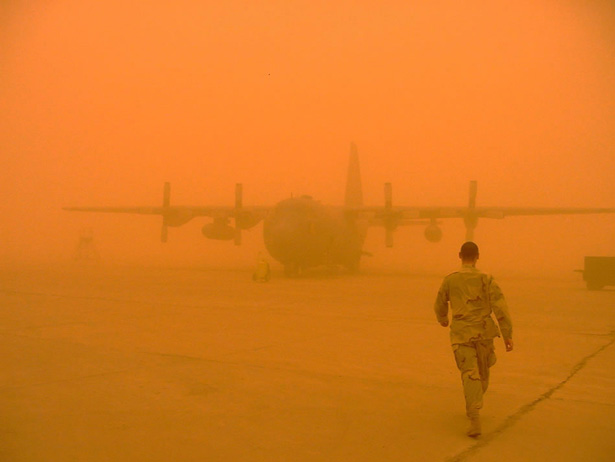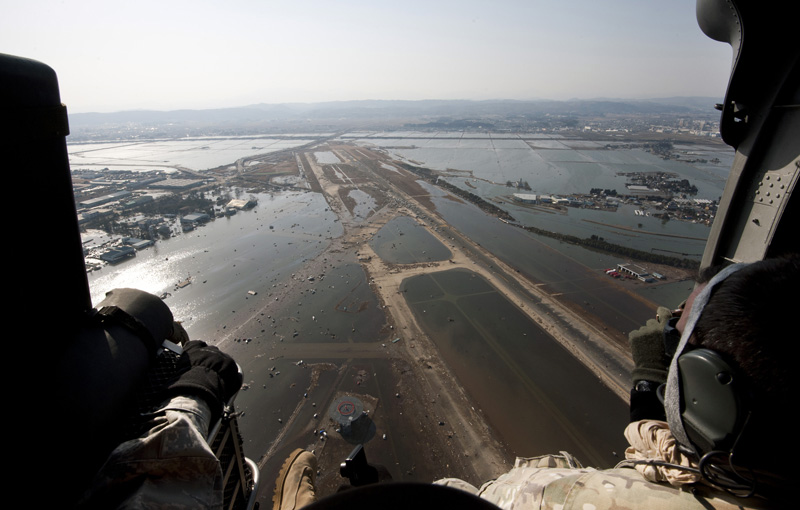-
Planning for Complex Risks: Environmental Change, Energy Security, and the Minerva Initiative
January 28, 2013 By Chad M. Briggs
2012 witnessed a remarkable number and extremity of environmental conditions, from Hurricane Sandy and the U.S. drought to wildfires in Siberia and drought-driven blackouts in India. Arctic sea ice melted to its furthest extent in recent history. The energy landscape continued to change as well, from the launch of the U.S. Navy’s Great Green Fleet to the first liquefied natural gas shipments across the Arctic. As President Obama clearly stated in his second inaugural address, climate change is heightening both our risks and the need to respond, but tying together all of these issues is a highly complex endeavor.
For the past two years the U.S. Air Force’s Minerva program – part of the broader Pentagon-wide Minerva Initiative to fund research on social, cultural, and political dynamics – took on just that challenge, in assessing energy and environmental security risks and their potential implications for U.S. military strategy and operations. Funded by the Office of the Secretary of Defense, our team, based at Air University, worked with U.S. combatant commands (primarily Pacific Command), other service components (the U.S. Navy Task Force Climate Change, U.S. Navy Task Force Energy, and U.S. Army Environmental Policy Institute), NATO, university researchers, intelligence communities, and partner countries as diverse as Sweden, Australia, Singapore, and Iraq.
“Phase Zero” Planning
The primary questions the Air Force Minerva team addressed were, how do energy and environmental factors affect U.S. strategic plans, force readiness, operational risks, and disaster response? And are there related indirect or cascading risks that will impact security planning?
We took an energy and environmental intelligence approach to these questions, building scenarios of potential combinations of risks and hazards and conducting net assessments on vulnerabilities, impacts, and our ability to respond. In contrast to predictive models, we applied military planning methods to scan potential risks, allowing a wider assessment of critical vulnerabilities.
Like much security planning, the questions centered not around “are we certain this will happen?” but rather “are we prepared in case this does happen?”
‘NATO Review’ on energy and environmental scarcity Advanced planning – sometimes referred to as “phase zero” planning in the military – helps to identify where to prioritize resilience-building and how to plan for disaster response and humanitarian assistance. Working with an array of partners, including University College London, Air University, University of Hawaii, the International Polar Year, NATO, and the International Institute for Strategic Studies, we organized scenario workshops to integrate a range of expert contributions with complex and unexamined risks.
An important emphasis in these workshops was that, as with the 2011 Japanese Tsunami (and subsequent U.S. Operation Tomodachi), energy and environmental risks need not lead to violence in order for the military or national security to be affected.
Operational security can be at risk when long logistical trains are needed to provide energy and water, or when environmental conditions pose acute risks to troops’ health or the proper functioning of vulnerable equipment. The 2010 and 2011 eruption of the Eyjafjallajoekull volcano in Iceland, for example, illustrated operational risks to aircraft from environmental hazards, and that experience has now been integrated into Air Force war games.
Events such as Hurricane Sandy also illustrate how ports, energy supplies, infrastructure, and transportation are vulnerable to extreme conditions even in advanced economies, suggesting that many of the most severe environmental-change risks may still be experienced in politically stable regions. This comes in contrast to a history of environmental security assessments that focused largely on less-developed or politically fragile regions.
Improbable Combinations of Probable Components
Hurricane Sandy also represented two important phenomena of energy-environmental hazards, one positive and one much more challenging.
The good news is that the United States has developed impressive early-warning capabilities for extreme hazards, from tsunami warning networks to weather modeling that allowed nearly a week’s notice of a potential superstorm around New England. Without these and advanced planning for such a scenario by New York City’s Office of Emergency Management and other agencies, the impacts of the storm could have been far worse.
The more troubling aspect of the storm is that we often take such early warning and planning for granted, both in terms of the monitoring technologies needed, and our scientific understanding of complex systems and tipping points. Sandy represented a type of disaster that often exists in complex systems: an improbable combination of entirely probable components. All the critical factors of Sandy – an Atlantic hurricane, Arctic cold front, southern-dipping jetstream track, high tides – were fairly common on their own, but the superstorm could only be understood when everything was combined.
‘NATO Review’ on environmental change and the armed forces In the long term, this suggests that environmental changes need not be extreme in order to create extreme effects – small changes in water temperature, for example, might trigger tipping points that greatly increase hazards and would be underestimated if viewed in isolation.
Since we tend to view environmental changes as gradual, linear processes, early warning systems tend to underestimate energy and environmental security risks as a rule, and officials are often surprised when disasters have far worse impacts than they expected. Addressing this challenge requires a systems approach to risk assessment, where tipping points and critical nodes and vulnerabilities are identified well in advance – a focus of our research efforts.
Strategic Impacts
The Air Force’s Minerva team also asked what the effect of these longer-term changes to risks might be on military strategy. What critical factors of energy and environmental security might pose significant strategic risks to the United States and its allies? And what combinations of those factors are most troubling?
These questions became central to a strategic assessment prepared for the Chief of Staff of the Air Force and carried out by us and the Air Force Research Institute.
The team’s research and assessments highlighted the importance of investing in alternative energy technologies and infrastructure, both to ensure operational readiness of U.S. forces, but also to decrease demands on the military for disaster assistance, increase cyber-security via more resilient smart-energy grids, and bolster operational security via transportation logistics. Environmental changes in the Arctic will also place new demands on strategies and operations, from search-and-rescue and oil spill response, to shifting trade routes and strategic partnerships.
Similar to some challenges posed by counter-insurgency strategies, we found that many energy and environmental security risks underlie broader, human security and resilience concepts. So while, for example, the Iraqi National Security Council has identified its shrinking water supply as a top security concern (Iraq lies downstream of Turkey, Syria, and Iran), traditional military responses don’t address ensuring adequate food and energy supplies. We also illustrated the challenges and security implications faced by critical countries, like China and India, in providing adequate water for energy, food, and industrial production – similar to the work done by Circle of Blue and the Wilson Center’s China Environment Forum. In China, rapid economic growth and energy demand has outstripped traditional water supplies, leading to large-scale river diversions that could impact downstream countries (India, Vietnam, Bangladesh, etc.) and complicate already-tense border disputes in areas like Arunachal Pradesh.
Likewise, the Air Force Minerva team identified tipping points in Pacific Ocean conditions that can increase hurricane risks to Hawaii, where a Sandy-like event on Oahu would leave a million residents without adequate food or energy. Other related assessments examined increased environmental risks to islands of the Pacific and Arctic regions and potential disaster and health-related risks from emerging energy technologies (such as undersea mining of methane clathrates).
Is Forward Engagement Possible?
In all these examples, U.S. security interests and operations could be disrupted, and only forward engagement and early warning can effectively address the risks – but not via Department of Defense policies alone.
Cooperation with the international and non-governmental organizations that ultimately provide long-term assistance is crucial. Important U.S. government agencies that should be working together more on these issues include the Department of State and USAID (as in the goals outlined in the first Quadrennial Diplomacy and Development Review), Department of Energy, Department of Homeland Security, and the Global Change Research Program. The intelligence community too has an obligation to coordinate better. The recent National Intelligence Council reports on water security and global trends to 2030 further underlined this point – that energy and environmental security concerns are not merely related to violence, and require whole-of-government approaches to both early warning and response.
Many elements of energy and environmental security cooperation already exist, from the Pacific Disaster Center and Pacific Command’s MPAT program to foster multinational disaster response (e.g. Operations Cobra Gold and Tempest Express). But such programs need to be sustained and after more than a decade of conflict, the U.S. military’s capabilities need to be reassessed.
The Minerva Initiative itself represents the other necessary step, of open engagement with the civilian scientific community, and helping to bridge the gaps between energy, environment, and military communities.
From 2010 to 2012, Chad M. Briggs was the Minerva Chair of Energy and Environmental Security at Air University. He is now the strategy director at GlobalInt. Many of the Minerva-related assessment projects are now finding new homes at GlobalInt and at key universities around the world. The rest of the Air Force Minerva team, without which the project would not have been possible, included Tracy Briggs, LTC (ret) Katie Veazie, COL (ret) Robyn Read, LTC (ret) Blair Ellis, Robert Sands, Erin Fitzgerald, COL (ret) Dan Henk, and the Office of the Secretary of Defense.
Photo Credit: A U.S. Air Force C-130 in Iraq during a sandstorm, courtesy of Jason Serrit/U.S. Department of Defense; Overflight of Sendai Airport, courtesy of the U.S. Department of Defense. Video Credit: NATO Review Magazine.
Topics: adaptation, Arctic, China, climate change, conflict, energy, environment, environmental security, featured, food security, foreign policy, Guest Contributor, India, Japan, military, NATO, natural gas, oceans, security, State, U.S., USAID, video, water
 A Publication of the Stimson Center.
A Publication of the Stimson Center.




